



























|



























Trade Card Grading
A Collector’s Guide the Grading of Trade Cards
Overview
As with any type of collecting, it’s always best to know the condition or grade of the collectable. To this end, the Professional Sports Authenticator (PSA) 10-point Grading Scale was developed as a guideline for the grading of trade cards. This standard was developed by a group of the nation’s leading trading card experts that recognized that in order for the trading card industry to realize its true potential, an industry-wide grading standard was needed. The PSA 10-Point Grading Scale, has developed into the standard for the industry and is accepted by professional trading card dealers, collectors, and leading auction houses.
Skytamer Images does not authenticate or grade cards. If you need to have your cards professionally graded, visit the Professional Sports Authenticator (PSA) website for details.
Click on the following thumbnail images to view full-size examples of the 10 card grades..
Definitions of Card Grades
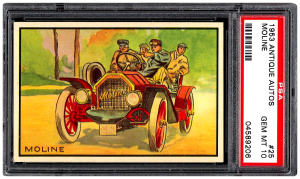 |
“Gem Mint” (GEM-MT 10) is a virtually perfect card. Attributes include:
- Four perfectly sharp corners
- Sharp focus
- Full original gloss
- Card must be free of staining of any kind, but an allowance may be made for a slight printing imperfection, if it does not impair the overall appeal of the card.
- Image must be centered on the card within a tolerance not to exceed approximately 55/45 to 60/40 percent on the front, and 75/25 percent on the reverse.
|
|---|
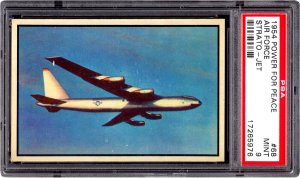 |
“Mint” (MINT 9) is a superb condition card that exhibits only one of the following minor flaws:
- A very slight wax stain on reverse.
- A minor printing imperfection or slightly off-white borders.
- Centering must be approximately 60/40 to 65/35 or better on the front and 90/10 or better on the reverse.
|
|---|
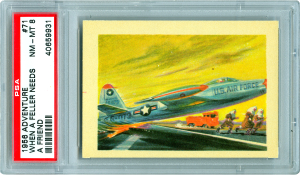 |
“Near Mint-Mint” (NM-MT 8) is a super high end card that appears Mint 9 at first glance. But upon closer inspection, the card can exhibit the following:
- A very slight wax stain on reverse
- Slightest fraying at one or two corners
- A minor printing imperfection and/or slightly off-white borders.
- Centering must be approximately 65/35 to 70/30 or better on the front and 90/10 or better on the reverse.
|
|---|
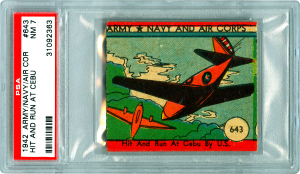 |
“Near Mint” (NM 7) cards exhibit the following characteristics:
- Slight surface wear is visible upon close inspection.
- There may be slight fraying on some corners.
- Picture focus may be slightly out-of-register.
- A minor printing blemish is acceptable.
- Slight wax staining is acceptable on the back of the card only.
- Most of the original gloss is retained.
- Centering must be approximately 70/30 to 75/25 or better on the front and 90/10 or better on the back.
|
|---|
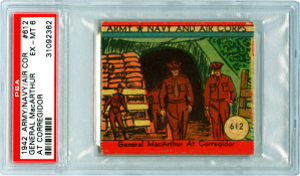 |
“Excellent-Mint” (EX-MT 6) cards exhibit the following characteristics:
- May have visible surface wear or a printing defect which does not detract from its overall appeal.
- A very light scratch may be detected only upon close inspection.
- Corners may have slightly graduated fraying.
- Picture focus may be slightly out of register.
- Card may show some loss of original gloss.
- May have minor wax stain on reverse.
- May exhibit very slight notching on edges.
- May also show some off-whiteness on borders.
- Centering must be 80/20 or better on the front and 90/10 or better on the reverse.
|
|---|
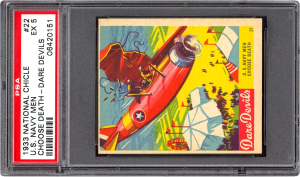 |
“Excellent” (EX 5) cards exhibit the following characteristics:
- Cards show very minor rounding of the corners that is becoming evident.
- Surface wear or printing defects are more visible.
- There may be minor chipping on edges.
- Loss of original gloss will be more apparent.
- Focus of picture may be slightly out of register.
- Several light scratches may be visible upon close inspection, but do not detract from the appeal of the card.
- Card may show some off-whiteness of borders.
- Centering must be 85/15 or better on the front and 90/10 or better on the back.
|
|---|
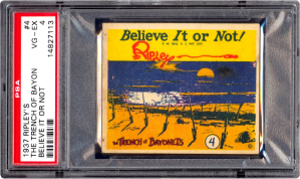 |
“Very Good-Excellent” (VG-EX 4) cards exhibit the following characteristics:
- Cards have corners that may be slightly rounded.
- Surface wear is noticeable but modest.
- The card may have light scuffing or light scratches.
- Some original gloss will be retained.
- Borders may be slightly off-white.
- A light crease may be visible.
- Centering must be 85/15 or better on the front and 90/10 or better on the back.
|
|---|
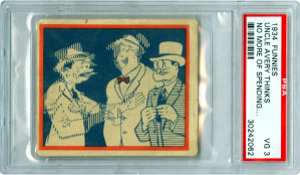 |
“Very Good” (VG 3) cards exhibit the following characteristics:
- Card reveals some rounding of the corners, though not extreme.
- Some surface wear will be apparent, along with possible light scuffing or light scratches.
- Focus may be somewhat off-register.
- Edges may exhibit noticeable wear.
- Much, but not all, of the card’s original gloss will be lost.
- Borders may be somewhat yellowed and/or discolored.
- A crease may be visible.
- Printing defects are possible.
- Slight stain may show on obverse and wax staining on reverse may be more prominent.
- Centering must be 90/10 or better on the front and back.
|
|---|
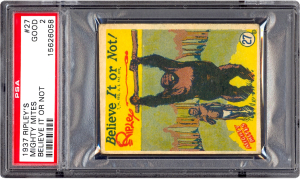 |
“Good” (G-2) cards exhibit the following characteristics:
- Card’s corners show accelerated rounding.
- Surface wear is starting to become obvious.
- Card may have scratching, scuffing, light staining, or chipping of enamel on obverse.
- There may be several creases.
- Original gloss may be completely absent.
- Card may show considerable discoloration.
- Centering must be 90/10 or better on the front and back.
|
|---|
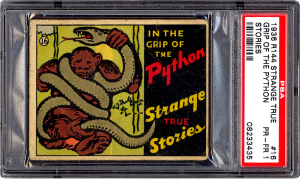 |
“Poor to Fair” (PR-FR 1) cards exhibit the following characteristics:
- Card’s corners will show extreme wear, possibly affecting framing of picture.
- Surface of card will show advanced stages of wear, including scuffing, scratching, pitting, chipping and staining.
- Picture will possibly be quite out of register.
- Borders may have become brown and dirty.
- May have one or more heavy creases.
- May be missing one or more small pieces
- May have major creasing and extreme discoloration or dirtiness throughout.
- Card may show noticeable warping.
- Centering must be 90/10 or better on the front and back.
|
|---|
Card Flaws
| OC |
Centering is determined by comparing the measurements of the borders from left to right and top to bottom. The centering is designated as the percent of difference at the most off-center part of the card. A 5% leeway is given to the front centering minimum standards for cards which grade NM 7 or better. For example, a card which meets all of the other requirements for MT 9 and measures 60/40 off center on the front automatically meets the PSA front centering standards for MT 9. If a card meets all of the other requirements for MT 9 and measures 65/35 off center on the front, it may be deemed to meet the PSA front centering standards for MT 9 if the eye appeal of the card is good. Cards with centering below the minimum standards for the grade will be designated OC. For example, a PSA Mint 9 card which is more than 65/35 off center on the front would be graded Mint 9 OC.
|
|---|
| ST |
Cards with staining below the minimum standards for the grade are designated ST.
|
|---|
| PD |
Cards with significant printing defects are designated as PD.
|
|---|
| OF |
Cards with focus below the minimum standards for the grade are designated as OF.
|
|---|
| MK |
Cards with writing, ink marks, pencil marks, etc. are designated as MK.
|
|---|
Ungradeable Cards - No Grade Definitions
|
If the grade of your card is available and is listed with one of the following grades, this card was determined to be ungradeable for the following reasons.
|
| N-1 |
Evidence of Trimming: When a card’s edge has been altered, a card doctor may use scissors, scalpel, cutter, or any other cutting instrument. A trimmed card may exhibit one of the following: (a) Hook up or down, (b) Have one razor sharp edge, (c) A difference in toning along the edge, or (d) A wavy look.
|
|---|
| N-2 |
Evidence of Restoration: When a card’s paper stock is built up - for example, when ripped corners are built up to look like new corners.
|
|---|
| N-3 | Evidence of Re-coloration: Where a card’s color has been artificially improved.
|
|---|
| N-4 | Questionable Authenticity: This is the term used when a card is counterfeit.
|
|---|
| N-5 |
Altered Stock: This term is used when the paper stock is altered in one or more of the following ways: Stretching and trimming, re-coloring and restoring, trimming and re-coloring, restoring an trimming, crease or wrinkle is pressed out, or gloss is enhanced.
|
|---|
| N-6 |
Minimum Size Requirement: When a card is significantly undersized according to factory specifications.
|
|---|
| N-7 |
Evidence of Cleaning: When a whitener is used to whiten borders or a solution is used to remove wax, candy, gum or tobacco stains.
|
|---|
| N-8 |
Miscut: This term is used when the factory cut is an abnormal cut.
|
|---|
| N-9 |
Don’t Grade: Non-graded cards may be oversized or an obscure issue.
|
|---|

|

































































